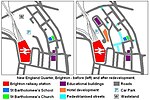Brighton railway works

Brighton railway works (also known as Brighton locomotive works, or just the Brighton works) was one of the earliest railway-owned locomotive repair works, founded in 1840 by the London and Brighton Railway in Brighton, England, and thus pre-dating the more famous railway works at Crewe, Doncaster and Swindon. The works grew steadily between 1841 and 1900 but efficient operation was always hampered by the restricted site, and there were several plans to close it and move the facility elsewhere. Nevertheless, between 1852 and 1957 more than 1200 steam locomotives as well as prototype diesel electric and electric locomotives were constructed there, before the eventual closure of the facility in 1962. After use as a factory for constructing bubble cars, the facility was demolished and has since been redeveloped as part of the New England Quarter of Brighton.
Excerpt from the Wikipedia article Brighton railway works (License: CC BY-SA 3.0, Authors, Images).Brighton railway works
York Hill, Brighton Round Hill
Geographical coordinates (GPS) Address Nearby Places Show on map
Geographical coordinates (GPS)
| Latitude | Longitude |
|---|---|
| N 50.831944444444 ° | E -0.13861111111111 ° |
Address
York Hill
York Hill
BN1 4GH Brighton, Round Hill
England, United Kingdom
Open on Google Maps











